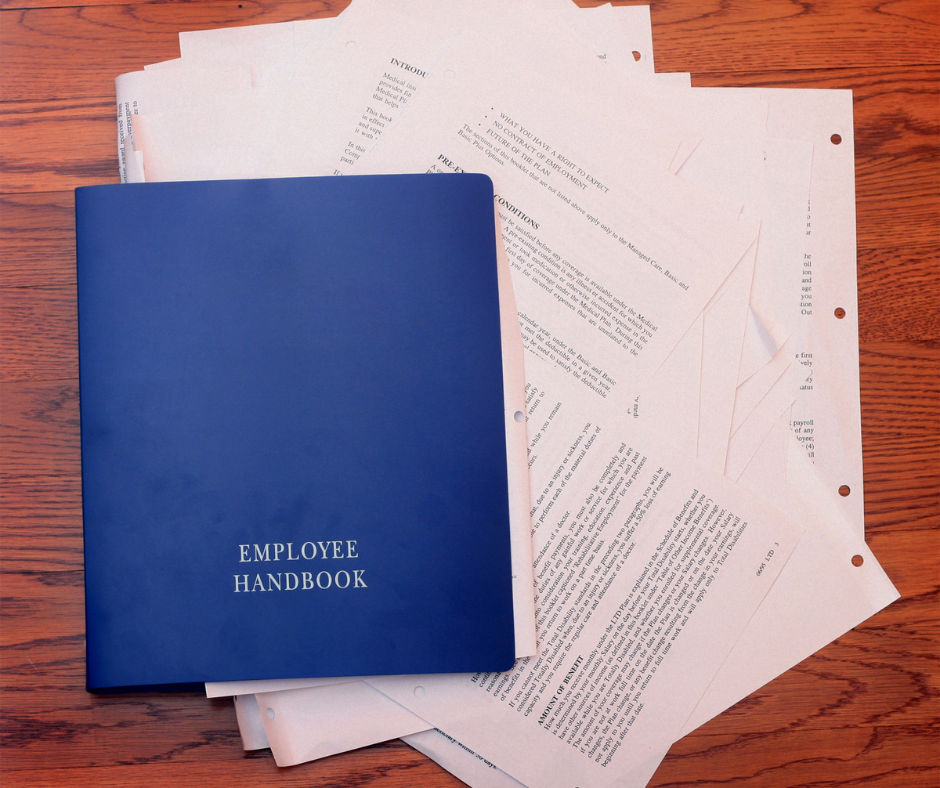
A well-crafted employee handbook is the backbone of a strong workplace culture, especially in the foodservice industry, where high turnover rates and labor shortages are prevalent. Are you looking to create an employee handbook for your US Foods Holding business that not only addresses industry challenges but also fosters a positive work environment? You’ve come to the right place – the “us foods holding employee handbook example.”
In this comprehensive guide, we’ll explore the essential components of a US Foods Holding Employee Handbook, from establishing company values and mission statement to ensuring legal compliance and employee engagement. Join us as we delve into the intricacies of creating an effective us foods holding employee handbook example that promotes a strong workplace culture and empowers your team to succeed.
Key Takeaways
- Employee handbooks are essential for US Foods Holding to build a strong workplace culture and meet industry-specific challenges.
- Key sections should include mission statement, code of conduct, anti-discrimination policies, legal compliance with laws & regulations.
- Implementing and enforcing the employee handbook is essential through training programs & periodic reviews/updates.
The Importance of an Employee Handbook for US Foods Holding
An employee handbook is more than just a set of rules and guidelines; it’s a compass that guides your employees through the intricacies of the work environment. For US Foods Holding, a meticulously designed employee handbook plays a significant role in building a robust workplace culture and tackling the unique challenges of the foodservice industry. It serves as a powerful tool for human resources to maintain a harmonious workplace, free from conflicts, harassment, and discrimination.
The employee handbook serves several important purposes:
- It details the company’s code of conduct, employment policies, and benefits, establishing explicit expectations for employees and managers alike.
- It helps employers avoid situations that may lead to non-compliance with local laws and regulations.
- It ensures a safe workplace that instills trust and enables employees to contribute and attain success.

Benefits of a Well-Structured Employee Handbook
A well-structured employee handbook offers numerous advantages that ultimately benefit the overall business. Enhanced communication, better training, and improved employee retention are just some of the benefits that can be reaped from a thoughtfully designed handbook. The incorporation of design elements like graphics and illustrations reflecting diversity, including gender identity, makes the handbook more captivating, reader-friendly, and memorable.
While specific statistics on employee retention may not be readily available, research suggests that a well-structured employee handbook addressing diversity, including sexual orientation, can contribute significantly to higher employee retention rates. The inclusion of positive aspects such as public affirmation of achievements can further encourage employees to interact with the handbook and avoid becoming disengaged.
Addressing Industry-Specific Challenges
To combat the unique challenges faced by foodservice companies like US Foods Holding, it’s essential that the employee handbook addresses industry-specific issues such as high turnover rates, labor shortages, and interactions with government officials. The employee handbook, by detailing a distinct code of conduct and providing guidelines to manage potential conflicts of interest, equips employees to confidently tackle these industry challenges.
Moreover, US Foods Holding adheres to wage and hour laws, necessitating that hourly associates clock out for lunch to ensure they receive the appropriate break, regardless of workload. By addressing these industry-specific challenges, the employee handbook not only serves as a comprehensive guide for employees but also helps the company maintain compliance with local, state, and federal regulations.
Key Sections to Include in a US Foods Holding Employee Handbook

To create an effective employee handbook for US Foods Holding, it’s crucial to include sections that encompass company values, workplace conduct, and diversity policies. These sections form the foundation of a strong workplace culture and ensure employees understand their roles and responsibilities within the company.
The inclusion of key components like a mission statement, code of conduct, and anti-discrimination policies transforms the employee handbook into a potent resource, guiding both employees and managers through the intricacies of the foodservice industry. In the following subsections, we will discuss these key sections in detail and provide insights on how to craft a comprehensive and effective employee handbook.
Establishing Company Values and Mission Statement
Establishing company values and mission statement is a crucial aspect of creating an employee handbook that resonates with your team. US Foods Holding is committed to exceeding expectations, providing top-notch products and services, and cultivating a diverse and inclusive work environment. The company’s mission statement is: “Our mission is to be a leading foodservice distributor by… In pursuit of this mission, we are committed to upholding the highest standards of quality, service, and integrity”.
The employee handbook serves several important purposes:
- It articulates the company’s mission and values, providing employees with a sense of direction and purpose.
- It instills a sense of pride in the organization and encourages employees to embrace the company’s values in their day-to-day work.
- It ensures that employees understand the broader goals of the organization and how their individual contributions align with the company’s objectives.
Workplace Conduct and Ethics

The workplace conduct and ethics section of a US Foods Holding employee handbook should encompass elements such as:
- A code of conduct and ethical standards
- Expectations of professional behavior and integrity
- Anti-discrimination and equal opportunity policies
- Guidelines for sustaining a respectful and inclusive workplace
- Policies on conflicts of interest and financial integrity
- Reporting mechanisms for ethics violations or concerns
- Consequences for breaching the code of conduct
- Training and education programs on workplace conduct and ethics.
A robust code of conduct is vital in defining behavioral expectations and standards for employees, especially in dealing with situations where interest arise, such as conflicts. Upholding the company’s code of conduct is critical for maintaining a positive work environment, fostering trust within teams, and protecting the company’s reputation.
To ensure adherence to the code of conduct, it’s imperative that associates comply with relevant laws and regulations. Failure to do so may detrimentally impact the company’s reputation and lead to severe consequences. The employee handbook, by setting clear expectations for workplace conduct and ethics, guides employees in navigating the complexities of the foodservice industry with integrity and professionalism.
Diversity, Inclusion, and Anti-Discrimination Policies
Diversity, inclusion, and anti-discrimination policies play a vital role in promoting a respectful and inclusive work environment. US Foods Holding highly values diversity and inclusion, understanding that it enhances their work and provides positive outcomes for their customers and communities. To nurture a safe and welcoming work environment, the inclusion of a comprehensive anti-harassment and complaint procedure section in the employee handbook, addressing issues such as national origin, is necessary.
Effective diversity, inclusion, and anti-discrimination policies in food industry employee handbooks may include:
- Equal Employment Opportunity
- Anti-Discrimination Policy
- Harassment Prevention
- Inclusion and Respect
- Accommodation for Disabilities
By incorporating such policies in the employee handbook, US Foods Holding demonstrates its commitment to creating a positive and inclusive work environment where every employee can thrive.
Warner Bros. Discovery Employee Handbook Example
In the Warner Bros. Discovery employee handbook example, employees gain valuable insights into the company’s policies and expectations. This comprehensive guide outlines the principles that shape the workplace culture, addressing topics such as professional conduct, diversity and inclusion, and benefits. The Warner Bros. Discovery employee handbook example serves as a roadmap, providing clarity on roles and responsibilities while fostering a positive and inclusive work environment. As employees navigate their careers within the company, this handbook stands as a reliable resource, ensuring a shared understanding of the organization’s values and fostering a collaborative and thriving workplace.
Legal Compliance and Local Regulations

To guarantee your employee handbook’s compliance with all relevant laws and regulations, consultation with human resources and legal experts during its creation is a must. These professionals can help you navigate the complexities of:
- labor laws
- anti-discrimination laws
- wage and hour laws
- workplace safety laws
This ensures that your handbook is legally sound and up-to-date with local law.
In the following subsections, we will discuss:
- The importance of consulting with human resources and legal experts
- Adapting to changing laws and regulations
- Guaranteeing that your US Foods Holding employee handbook remains compliant and serves as a reliable resource for your employees.
Consulting with Human Resources and Legal Experts
The consultation with human resources and legal experts is of immense value in assuring your employee handbook’s compliance with employment laws and regulations. These experts can provide guidance on topics such as:
- discrimination
- harassment
- wage and hour laws
- employee rights
This helps protect your company from potential legal disputes and ensures that the policies and procedures outlined in the handbook are legally sound.
Failure to consult with HR and legal professionals during the creation process could result in your company facing several negative consequences, including:
- Being legally non-compliant
- Having inaccurate or outdated policies
- Increased liability
- Lack of consistency
By seeking the advice of experts, you can ensure that your employee handbook accurately reflects employment laws and regulations and fosters a positive work environment that adheres to legal requirements.
Adapting to Changing Laws and Regulations
With laws and regulations perpetually changing, it becomes indispensable to frequently review and update your employee handbook to sustain compliance. For instance, recent changes in US labor laws, such as an increase in minimum wage, new regulations on noncompete clauses, and pay transparency regulations, should be taken into account when updating your employee handbook.
It’s recommended to review and update your employee handbook annually or as necessary to ensure compliance with changing laws and regulations. By staying up-to-date with legal requirements and adapting your handbook accordingly, you can better protect your company and employees while fostering a strong workplace culture that values compliance and integrity.
Engaging Employees in the Handbook Creation Process

Involving your employees in the handbook creation process can lead to a more comprehensive and effective employee handbook that truly reflects the needs and values of your workforce. By engaging employees as colleagues and enacting leadership methods that include listening to their thoughts, opinions, and ideas, you can foster a sense of ownership and involvement in the process.
In the following subsections, we will discuss strategies for seeking input from senior staff and managers, as well as encouraging employee feedback and suggestions, to ensure your US Foods Holding employee handbook reflects the unique perspectives and insights of your entire team.
Seeking Input from Senior Staff and Managers
Gaining insights from senior staff and managers is key to crafting an employee handbook that mirrors your company’s culture and expectations accurately. Senior staff members have the most comprehensive understanding of what constitutes appropriate workplace behavior and procedures, and their input can ensure that the policies and directives in the handbook are practicable and in line with the company’s objectives.
In addition to providing valuable insights into the needs and concerns of employees in their respective departments, managers can help ensure that the policies and directives in the handbook are in accordance with the company’s culture and values. By involving senior staff and managers in the creation process, you can create a more comprehensive and relevant employee handbook that truly resonates with your team.
Encouraging Employee Feedback and Suggestions
Encouragement for employee feedback and suggestions can foster a stronger sense of ownership and commitment towards the handbook’s policies. By creating a culture of open communication and transparency, implementing regular feedback sessions or surveys, providing opportunities for anonymous feedback, and actively listening to employee feedback, you can foster an environment where employees feel valued and heard.
Incorporating employee suggestions into the employee handbook not only makes it a more collaborative and inclusive document but also ensures that the handbook accurately reflects the company’s culture, values, and policies. By engaging employees in the handbook creation process, you can create a stronger workplace culture that empowers your team to succeed.
Implementing and Enforcing the Employee Handbook

Upon completion of your US Foods Holding employee handbook, implementing and enforcing its policies through the following steps is fundamental:
- Training: Familiarize new employees with the handbook and its policies.
- Onboarding programs: Incorporate the handbook into the onboarding process to ensure all employees are aware of the policies.
- Routine reviews: Regularly review the handbook with employees to reinforce the policies and address any questions or concerns.
By following these steps and ensuring a smooth check in line process, you can create a strong foundation for a successful and harmonious work environment, contributing to the overall well being of your employees.
In the following subsections, we will discuss the importance of training and onboarding programs, as well as the need for periodic reviews and updates, to ensure your employee handbook remains relevant and effective in maintaining a strong workplace culture.
Training and Onboarding Programs
Training and onboarding programs assume a central role in acquainting new employees with the employee handbook and its policies. By providing orientation and having new employees read through the restaurant training manual and employee handbook, you can ensure they understand the company’s regulations, processes, and culture. Online training resources and ongoing training for staff can further reinforce the importance of adhering to the policies outlined in the handbook.
A well-implemented onboarding program not only guarantees a seamless transition for new employees into their roles but also furnishes them with the necessary tools and information to achieve success in their positions. By investing in thorough training and onboarding programs, you can create a solid foundation for a positive and compliant work environment.
Periodic Reviews and Updates
Frequent review and updates to your employee handbook are necessary to keep it relevant and effective in maintaining a robust workplace culture. As laws and regulations change, your handbook must also adapt to stay compliant and relevant to your employees’ needs.
It’s recommended to review and update your employee handbook annually or as necessary, taking into account any changes in laws, regulations, or company policies. By staying up-to-date with legal requirements and adapting your handbook accordingly, you can better protect your company and employees while fostering a strong workplace culture that values compliance and integrity.
3M Employee Handbook Example
In the comprehensive 3M employee handbook example, employees gain valuable insights into the company’s policies, values, and expectations. This 3M employee handbook example serves as a guide for new hires and a reference for existing staff members. Covering a wide range of topics, from workplace conduct to benefits and beyond, the 3M employee handbook example reflects the company’s commitment to fostering a positive and inclusive work environment. Through this handbook, employees can navigate the various facets of their employment journey at 3M, ensuring a shared understanding of the company’s culture and standards.
Summary
In conclusion, creating a comprehensive and effective employee handbook for your US Foods Holding business is a critical component in fostering a strong workplace culture and addressing industry-specific challenges. By incorporating key sections such as company values, workplace conduct, and diversity policies, and ensuring compliance with legal requirements through consultation with human resources and legal experts, your employee handbook will serve as a valuable resource for your entire team.
Remember, engaging employees in the handbook creation process, implementing thorough training and onboarding programs, and regularly reviewing and updating your handbook are essential steps in maintaining a positive and compliant work environment. With a well-crafted employee handbook as your compass, your US Foods Holding business will be well-equipped to navigate the complexities of the foodservice industry and empower your team to succeed.
Frequently Asked Questions
What percentage does US Foods 401k match?
US Foods offers a 401k match of either 2% or 3%, so you can receive up to 3% of your contribution matched by the company.
What does US Foods Holding Corp do?
US Foods Holding Corp is a leading foodservice distributor offering products such as fresh, frozen and dry food, meat, seafood, beverages and other produce to customers throughout the United States. It partners with approximately 300,000 restaurants and foodservice operators to help their businesses succeed.
What is the US Foods Supplier Code of Conduct?
At US Foods, we hold our Supplier Code of Conduct to the highest ethical standards. We expect suppliers to have policies and controls in place to prevent and detect any misuse of assets, bribery, conflicts of interest, improper gifts, fraud, embezzlement, and other unethical behaviors.
What is the mission statement of US Foods?
US Foods’ mission is to use food to provide people with a better future, distributing quality products and giving back to communities to empower people.
What are the key components of a US Foods Holding employee handbook?
The key components of a US Foods Holding employee handbook include sections on company values, workplace conduct, and diversity policies.
Important Disclaimer:
The article presented here does not serve as a representation of the company’s actual employee handbook mentioned in this article.
Our discussions and insights regarding employee handbook are based on assumptions about what may be considered significant in this companies’ policies. These assumptions are drawn from available information and industry knowledge. Readers are advised that the content provided is for informational purposes only and should not be construed as an exact reflection of any company’s official policies or procedures. For precise and accurate details regarding a company’s employee handbook, individuals should refer directly to the company’s official documentation or consult with appropriate representatives.
Please be aware that the content on this page has been generated by using artificial intelligence language models and may contain errors, inconsistencies, or outdated information. It is provided as-is without any warranties or guarantees of accuracy. We strongly recommend using this content as a starting point for further research. We disclaim any liability for damages or losses resulting from the use or reliance on this content.